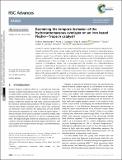Files in this item
Examining the temporal behavior of the hydrocarbonaceous overlayer on an iron based Fischer-Tropsch catalyst
Item metadata
| dc.contributor.author | Warringham, Robbie | |
| dc.contributor.author | Davidson, Alisha L. | |
| dc.contributor.author | Webb, Paul B. | |
| dc.contributor.author | Tooze, Robert P. | |
| dc.contributor.author | Ewings, Russel A. | |
| dc.contributor.author | Parker, Stewart F. | |
| dc.contributor.author | Lennon, David | |
| dc.date.accessioned | 2019-02-18T10:30:05Z | |
| dc.date.available | 2019-02-18T10:30:05Z | |
| dc.date.issued | 2019-01-23 | |
| dc.identifier | 257774847 | |
| dc.identifier | 479532de-4784-4731-b34c-808bb42f631b | |
| dc.identifier | 000457379300034 | |
| dc.identifier | 85060643681 | |
| dc.identifier | 000457379300034 | |
| dc.identifier.citation | Warringham , R , Davidson , A L , Webb , P B , Tooze , R P , Ewings , R A , Parker , S F & Lennon , D 2019 , ' Examining the temporal behavior of the hydrocarbonaceous overlayer on an iron based Fischer-Tropsch catalyst ' , RSC Advances , vol. 9 , no. 5 , pp. 2608-2617 . https://doi.org/10.1039/c8ra09731c | en |
| dc.identifier.issn | 2046-2069 | |
| dc.identifier.other | ORCID: /0000-0003-2532-344X/work/67167795 | |
| dc.identifier.uri | https://hdl.handle.net/10023/17085 | |
| dc.description | Sasol Ltd., the University of Glasgow and the EPSRC (grant numbers EP/P504937/1 and EP/P505534/1) are thanked for the provision of postgraduate studentships (RW and ALD). The Royal Society is thanked for the provision of an Industrial Fellowship (PBW). | en |
| dc.description.abstract | In order to examine fundamental processes connected with the use of an unpromoted iron based Fischer–Tropsch synthesis (FTS) catalyst, model studies examining the temporal formation of hydrocarbonaceous species that form over the catalyst are undertaken using a combination of temperature-programmed oxidation, powder X-ray diffraction, Raman scattering, transmission electron microscopy and inelastic neutron scattering (INS). Catalyst samples were exposed to ambient pressure CO hydrogenation at 623 K for defined periods of time-on-stream (3, 6, 12 and 24 h) prior to analysis. INS reveals a progressive retention of hydrogenous species that is associated with the evolution of a hydrocarbonaceous overlayer, as evidenced by the presence of sp2 and sp3 hybridized C–H vibrational modes. Correlations between the formation of aliphatic and olefinic/aromatic moieties with post-reaction characterization leads to the proposal of a number of chemical transformations that, collectively, define the conditioning phase of the catalyst under the specified set of reaction conditions. A comparison between the inelastic neutron scattering spectra of the 24 h sample with that of an iron catalyst extracted from a commercial grade Fischer–Tropsch reactor validates the relevance of the experimental approach adopted. | |
| dc.format.extent | 10 | |
| dc.format.extent | 1146753 | |
| dc.language.iso | eng | |
| dc.relation.ispartof | RSC Advances | en |
| dc.subject | QD Chemistry | en |
| dc.subject | NDAS | en |
| dc.subject.lcc | QD | en |
| dc.title | Examining the temporal behavior of the hydrocarbonaceous overlayer on an iron based Fischer-Tropsch catalyst | en |
| dc.type | Journal article | en |
| dc.contributor.sponsor | The Royal Society | en |
| dc.contributor.institution | University of St Andrews. School of Chemistry | en |
| dc.identifier.doi | https://doi.org/10.1039/c8ra09731c | |
| dc.description.status | Peer reviewed | en |
| dc.identifier.grantnumber | IF140013 | en |
This item appears in the following Collection(s)
Items in the St Andrews Research Repository are protected by copyright, with all rights reserved, unless otherwise indicated.

